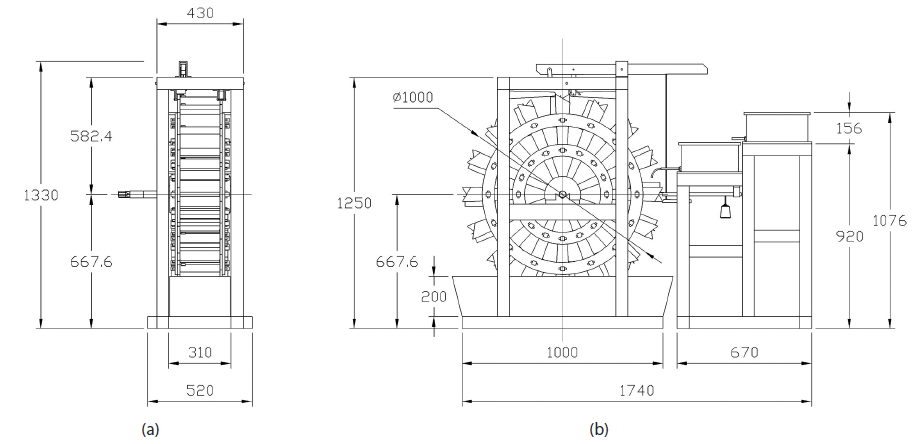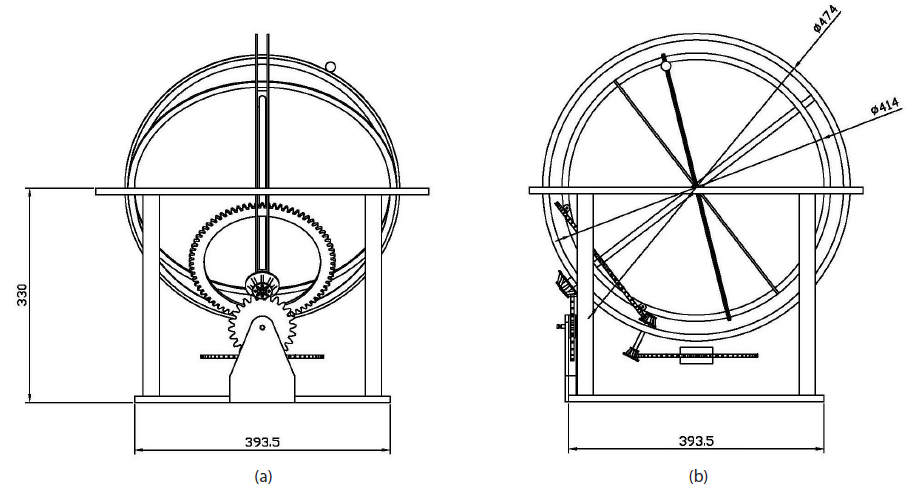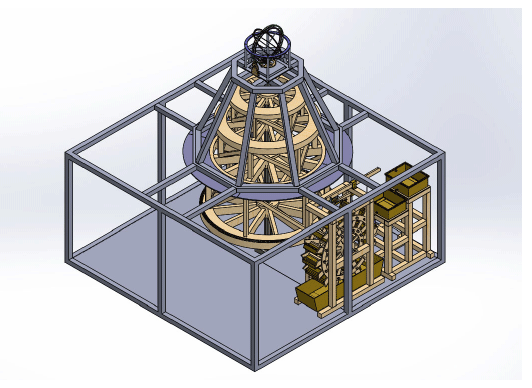1.INTRODUCTION
Heumgyeonggak-nu (欽敬閣漏) is an automated water clock of the Joseon Dynasty that was installed within Heumgyeonggak (欽敬閣), and it was manufactured in the 20th year of the reign of King Sejong (1438). The automated water clocks of the early Joseon Dynasty include Borugak-nu (報漏閣漏) and Heumgyeonggak-nu (欽敬閣漏), which were designed by King Sejong and developed by Jang, Yeong-sil (蔣英實) (Mihn et al. 2016). In general, Borugak-nu (報漏閣漏) was the national ‘standard clock’ of the palace and Hanseong (漢城, Capital of Joseon), and Heumgyeonggak-nu (欽敬閣漏) was an ‘astronomical clock’ in which the political thought focusing on agriculture was expressed by the movement of celestial bodies and the change of seasons. In other words, Heumgyeonggak-nu is a representative water clock of the early Joseon Dynasty, along with Borugak-nu, and is a monumental invention that combined the science and technology of China and the Islamic countries at the time. Although there had been several losses and restorations of Heumgyeonggak-nu, it was renowned as the water clock of the Joseon Dynasty for at least 180 years.
As for the record of Heumgyeonggak-nu, several clues can be found in the Annals of the Joseon Dynasty and Gukjobogam (國 朝寶鑑). In the case of Borugak-nu, the internal structure and operation mechanism are described in detail; but in the case of Heumgyeonggak-nu, the description is mainly focused on the display of the external ornaments, operation of the time signal puppets, and the Confucian symbols. The lack of information on the internal structure, compared with the aforementioned records on the external shape, has been the major difficulty in research for the restoration of Heumgyeonggak-nu. After the record on the correction instruction of Heumgyeonggaknu in 1617, the restoration of Heumgyeonggak-nu could not be accomplished for the last 400 years.
Kim et al. (2013) estimated that Heumgyeonggak-nu had been operated and used from 1438 to 1617. Heumgyeonggak and Heumgyeonggak-nu were burned down in 1533 (the 8th year of the reign of King Myeongjong) due to a fire in Gyeongbokgung Palace. The pavilions and water clock were then reconstructed, but were lost again during the Japanese Invasions of Korea (1592~1598). The fact that a water clock was operated again after years can be found in the repair record of Heumgyeonggaknu (1614) in Gwanghaegun-ilgi. Considering that the correction of Heumgyeonggak was mentioned until 1617, it is thought that it was manufactured more than three times, since its first invention in the reign of King Sejong, including the initial manufacture.
Needham et al. (1986) and Jeon (1994) suggested that Heumgyeonggak-nu was manufactured under the direct influence of Gung-nu (宮漏) from the Yuan Dynasty (元代) of China. Needham et al. (1986) suggested that the power mechanism of Heumgyeonggak-nu was, in part, buoyancy, as in Borugak-nu. In contrast, Jeon (1994) paid attention to the operation mechanism of Shui Yun Yi Xiang Tai (水運儀象臺) from the Northern Song Dynasty (北宋代) of China. Also, he explained the characteristics observed in Gung-nu and Islamic water clocks, in relation to the entrance and exit of Sasin (司 辰, hour-jack) & Musas (武士, striking puppets) and 12 gods & ognyeos (玉女, jade female immortals).
Research with the aim of restoring Heumgyeonggak-nu was first attempted by researchers in North Korea. In the 『History of Technological Development in Joseon』, it was suggested that the major power mechanism of Heumgyeonggak-nu was buoyancy, as in Borugak-nu (Choi et al. 1997). Also, signal generation by a lug was suggested; and for the movement of the sun, a long rod was used to change the altitude depending on the season. The suggestion of the lug can be considered as an effective and simple signal generation method. However, Hahn et al. (2000) and Kim et al. (2011, 2013, 2016) suggested that the power mechanism was a water-hammering type (水 激式), and the movement of the sun was based on the use of an armillary sphere.
Heumgyeonggak-nu can be divided into the external area of the replica of a mountain where 37 time signal puppets convey the time through the display of rotation, hammering, and emergence; and the internal space such as Si (時, double hours in modern time), Gyeong (更, divide night into five equal parts), Jeom (點, divide Gyeong into five equal parts) hammering apparatus by the water clock, mechanism wheel, water wheel, Cheonhyeong (天衡, oriental escapement), and Jujeon (籌箭, calculating apparatus of stick) (Kim et al. 2013). Based on this, the internal components that can be operated by the generation and control of power were introduced. On the other hand, it was found that the core apparatus for the constant power generation and control of the water wheel was Cheonhyeong, and the development and operation structure of the corresponding technique were analyzed (Kim et al. 2016).
However, in terms of the limitations of previous studies, the process in which the power generated from the water wheel is transferred to the mechanism wheel on each floor was not explained in detail, and the power generation for the rotation gear wheel on each floor was conceptually suggested. Also, for the arrangement of 4-god ognyeo and 4 gods in the external aerial view of Heumgyeonggak-nu, issues to reconsider have been newly found. Therefore, in the present study, the transmission process and structure of the power generated from the water wheel were more clearly presented. In addition, the technical problems of the basic three-story structure (fourstory structure when the movement of the sun is included) for the rotation gear wheel within the replica of a mountain were examined, and a new mechanism wheel with a fivestory structure was suggested, which improved the structural stability and rotation capability.
We investigated the internal structure through a structural analysis of the power generation and transmission system based on the existing research. In Section 2, the size of Heumgyeonggak, the position correction of 4-god ognyeo and 4 gods, and the water supply apparatus were reviewed, while in Sections 3 and 4, the analysis and design of the power mechanism were presented. In Section 5, the major components of Shui Yun Yi Xiang Tai and Heumgyeonggak-nu were reviewed, and in Section 6, the results for the structure and design of power transmission were summarized.
2.FACTORS FOR NEW CONSIDERATION
According to the record of Sejong Sillok (世宗實錄), Heumgyeonggak is a single room-sized small pavilion.1Heumgyeonggaknu was installed within Heumgyeonggak. The external shape of Heumgyeonggak-nu as described in <Heumgyeonggak-gi (欽敬閣 己)> by Kim, Don (金墩, 1385~1440) consists of an replica of a mountain (假山) and a wooden case (木櫃).2 The mountain is placed on top of the wooden case, and the circumference of the mountain forms the horizon. The form of the wooden case includes the horizon, and it is thought to be a quadrilateral shape according to Cheonwon-jibang-seol (天圓地方說, theory that the sky is round and the ground is square). Various mechanism wheels and a water wheel are installed inside the replica mountain and the wooden case.
The replica of a mountain is made of paper coated with glue, and the height is about 7 ja [尺].3 For manufacturing of astronomical instruments in the Joseon Dynasty, jucheok (周尺) was used as the scale unit. Thus, when the jucheok value of 1 ja (20.7 cm) is applied, the height of the replica mountain is approximately 144.9 cm. Also, for the rotation of the various mechanism wheels within the mountain, the size of the water wheel within the wooden case is estimated to be approximately 4~6 ja. When the size of the water wheel is 4 ja, it is 82.8 cm; and when the size is 6 ja, it is 124.2 cm. Therefore, considering that the height of the wooden case with the operation device is approximately 7 ja, the total height of Heumgyeonggak-nu including the replica mountain amounts to 14 ja. This is a height that corresponds to 289.8 cm above the ground’s surface.
However, for this huge apparatus, it is inconvenient to view the display of the time signal puppets on the horizon and the replica of a mountain. Fortunately, a picture could be found in which the form of Heumgyeonggak in Gyeongbokgung can be examined. Fig. 1 shows <Gyeongbokgung-do (景福宮圖)> at the Sotheby’s Korean art auction (March 18, 1997, New York, United States) (Lee 1998). Heumgyeonggak portrayed in this picture is a multi-storied pavilion that is higher than the ground’s surface, unlike the nearby pavilions. Thus, when the wooden case that includes the mechanism wheel and various mechanical devices is lowered down to the ground’s surface, it resolves the aforementioned inconvenience of viewing the time signal puppets.
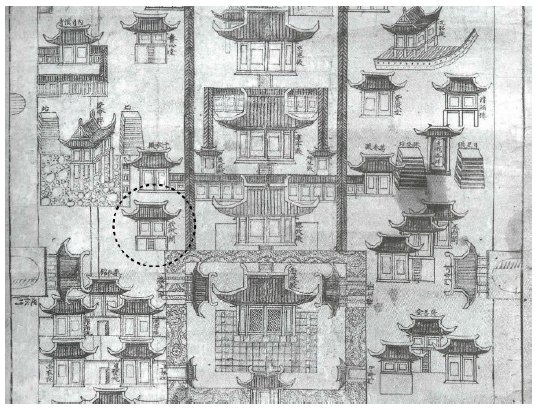
As a result, when only 2~3 ja (41.4 cm ~ 62.1 cm) of the wooden case estimated above the floor surface of the multistoried pavilion and the remaining part is installed on the ground’s surface, the detailed display of the 37 time signal puppets on the replica mountain can be examined without exception. In practice, for the maintenance of the mechanism wheel and water wheel of Heumgyeonggak-nu, it is advantageous to use a building such as the multi-storied pavilion.
Time signal puppets are located on the replica mountain of Heumgyeonggak-nu. Sun apparatus is located at the top of the mountain, and 4-god ognyeo and 4 gods are located below the sun apparatus. For the arrangement of 4-god ognyeo and 4 gods, Nam (2002) and Kim et al. (2011, 2013) arranged them at the same height of the same space. This is based on the literature interpretation of <Heumgyeonggak-gi> (article of Heumgyeonggak-nu) recorded in Sejong Sillok (世宗實錄).
『Sejong Sillok』 is a reissued version that is a reprint of the Jeonjusago (全州史庫) version, which is the only version that remained after the Japanese Invasions of Korea, among the ones printed in the 3rd year of the reign of King Seongjong (1472), and includes some misprints and omissions. We performed the analysis through comparison with Dongmunseon (東文選), which was compiled by Seo, Geo-jeong (徐居正, 1420~1488) in the 9th year of the reign of King Seongjong (1478) under orders from King Seongjong. <Heumgyeonggakgi> is described in a total of 888 characters, and eight spots are different (By comparing the two records). There are three spots where the variant forms of Chinese characters and the traditional Chinese characters are used: one spot that does not exist in Sejong Sillok but exists in Dongmunseon, one spot that exists in Sejong Sillok but does not exist in Dongmunseon, and three spots that are different between Sejong Sillok and Dongmunseon. Table 1 summarizes the three spots where the characters in Sejong Sillok and Dongmunseon are different.

|
In this regard, the noteworthy point is the interpretation of ‘傍’ and ‘方.’ This is because the position relationship of 4-god ognyeo and 4 gods could be confusing. The existing study mentioned that 4-god ognyeo and 4 gods were placed next to each other. The preceding sentence related to this reads “Four ognyeos are below the sun (日下有玉女四人) ∙∙∙ (omission) ∙∙∙ Four gods are below (下有四神)”. Thus, when the context of the sentence is connected and examined, the 4 gods need to be located below 4-god ognyeo. Accordingly, the expression of Dongmunseon is correct, where the meaning of ‘方’ was used rather than that of ‘傍’. Therefore, the positions of 4-god ognyeo and 4 gods on the mountain suggested in the existing research the imaginary diagram of Ong-nu (Nam 2002) and the 3D modeling and scale model (Kim et al. 2011, 2013) need to be corrected.
The water supply apparatus consists of a water storage tank and large/middle/small-sized outflow vessels. The water storage tank has the purpose of storing the water (refer to Fig. 2). The large-sized outflow vessel is the largest of the three outflow vessels, and the water flowing from the large-sized outflow vessel is transferred to the middle-sized outflow vessel and the small-sized outflow vessel. At the same time, extra water (i.e., the water through the overflow tube) is transferred to the waterfall, pond, and tilting vessel. In this regard, the extra water indicates the water of the large-sized outflow vessel. This is because the middle-sized outflow vessel and the small-sized outflow vessel are located within the wooden case that supports the replica mountain, which makes it difficult to supply water to the mountain. Therefore, the remaining water is drained from the largesized outflow vessel, which has been installed higher than the position of the waterfall, through the overflow tube, and it flows to the middle-sized outflow vessel through the stream tube located below the large-sized outflow vessel.
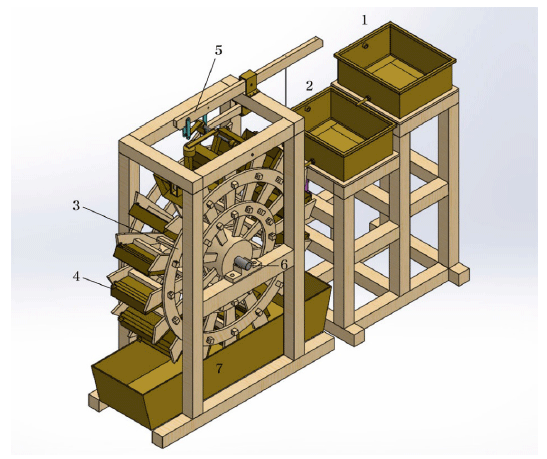
There is a record of engraving an inscription (銘) on the Cheonjiho (天地壺) of the water clock in the 6th year of Gwanghaegun’s rule (1614).4 In the four-stage water clock by Yeojae (呂才) in the Tang Dynasty (唐代) of China, the floors were arranged under the names of Manbunho (萬分壺), Pyeongho (平 壺), Ilcheonji (日天地), and Yacheonji (夜天地), from the bottom floor to the top floor. The Yeonhwa-nu (蓮花漏) by Wangbo (王普) in the Song Dynasty was an overflow-type three-stage water clock, and the floors were called Pyeongsusoho (平水小 壺), Pyeongsuho (平水壺), and Cheonjiho (天地壺), from the bottom floor to the top floor. Pan (2005) mentioned that this overflow-type multi-stage water clock was a standard form in the Yuan Dynasty, the Ming Dynasty of Chian, and the Qing Dynasty of China. Therefore, it is thought that Cheonjiho of Heumgyeonggak-nu indicates the large-sized outflow vessel located at the top of the outflow vessels. Also, it was common for the large-sized outflow vessel with the engraved inscription (銘) to be located in a position that can be easily viewed at all times. Considering this situation, it is thought that the small-sized outflow vessel and the middle-sized outflow vessel were installed inside the wooden case along with the water wheel, and the large-sized outflow vessel was installed outside the replica mountain along with the water storage tank.
3.ANALYSIS OF THE POWER TRANSMISSION MECHANISM
The water wheel control system consists of water wheel, scoop, Cheonhyeong apparatus (escapement), water wheel main shaft, and sump (refer to Fig. 2). The power of the water wheel rotates the five-story mechanism wheels. In this regard, the Cheonhyeong apparatus is involved in the constant rotation of the water wheel. The Cheonhyeong apparatus can be considered a sort of scale apparatus. By measuring the weight of the water contained in the scoop attached to the water wheel, the rotation and stoppage of the water wheel are periodically repeated, and a constant speed is obtained as a result (Kim et al. 2016).
The scoop contains a certain amount of water depending on the time. As well, it should be capable of pouring out the contained water all at once. If water remains in the scoop, precise operation and stoppage of the water wheel can be interrupted. Therefore, in this study, the interior of the scoop was made to be inclined by 45° so that water could be efficiently drained during the rotation of the water wheel (refer to 4. Scoop in Fig. 2). Also, the scoop was designed as a fixed-type scoop so that it could be applied to a traditional water wheel (Kim et al. 2013, 2016).
There is no record in the literature of the number of scoops for Heumgyeonggak-nu. But for the water wheel system for test manufactured by Hong, Dae-yong in the late Joseon Dynasty, four scoops were installed; in the case of Shui Yun Yi Xiang Tai in the Northern Song Dynasty, 36 or 48 scoops were installed. In the present study, 16 scoops were used considering the size of the water wheel (Kim et al. 2016). The size of the scoop was 20(w)×15(d)×5(h) cm, and one side of the scoop interior where water is poured out was inclined 45°. Accordingly, one scoop contains approximately 1.25 l of water. The water wheel was designed to rotate 61 times a day, and thus at least 1,220 l of water is needed. Considering the basic operation of the water storage tank and the three-stage outflow vessels, a much larger amount of water is necessary.
According to Kim et al. (2011), the interior of the replica of a mountain for Heumgyeonggak-nu consists of basic threestory mechanism wheels. The positions of 4-god ognyeo and 4 gods mentioned earlier can be separated as individual mechanism wheels. However, as it is not a complex operation, the basic three-story structure does not need to be subdivided. Thus, 4-god ognyeo and 4 gods were installed on the same mechanism wheel, and the positions of 4-god ognyeo and 4 gods were considered using a lug with a height difference. On the other hand, as the diurnal motion and annual motion of the sun need to be implemented, a separate mechanism wheel was installed at the top of the mountain.
In addition to this four-story structure of the interior of the replica of a mountain, there is a separate mechanism wheel (i.e., the bottommost mechanism wheel) for the stable rotation of the all wheels in the mechanism (refer to Fig. 3). The key function of this mechanism wheel is to cause the power generated from the water wheel main shaft to move the above four mechanism wheels at the same time. Accordingly, a total of five mechanism wheels were used.
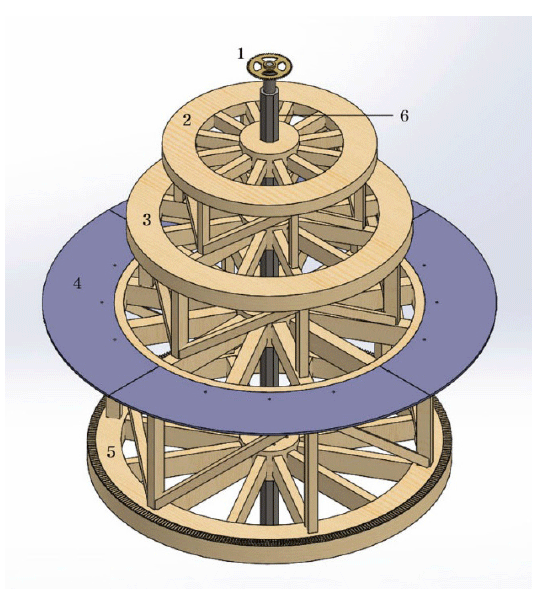
The five mechanism wheels are connected to the mechanism wheel main shaft that has been vertically installed, and each mechanism wheel is connected using a trussed structure so that structural stability and efficient torque can be obtained. For Shui Yun Yi Xiang Tai (Xin Yi Xiang Fa Yao (新儀象法要)) in the Northern Song Dynasty, a total of eight time-keeping wheels (晝夜機輪) were installed. Among them, five day-and-night gear wheels were used to report the time information, and the remaining mechanism wheels were used for power transmission or structural stability. The mechanism wheel structure of Heumgyeonggak-nu is simpler and smaller than that of Shui Yun Yi Xiang Tai, and thus, all operations can be implemented using five mechanism wheels.
A total of five stories of mechanism wheels are installed within the replica of a mountain and the wooden case. Among them, the top four floors are involved in the movement of the sun, operation of 4-god ognyeo and 4 gods, operation of the time signal puppets and generation of sound signal depending on the hammering of bell∙drum∙gong on the time signal platform, and operation of 12-god ognyeo and 12 gods, respectively. Kim et al. (2013) suggested that signal generation using a lug is efficient for the mechanism wheels relevant to the 4 gods, time signal, and 12 gods. However, for the celestial gear wheel involved in the movement of the sun, a toothed gear structure needs to be used, rather than a lug. This is because an elaborate toothed gear is advantageous for expressing the movement of the sun during a day or the position of the sun on the ecliptic during a year.
The celestial gear wheel is operated by the rotation of the power gear wheel, similar to the other mechanism wheels. The power gear wheel is operated by the power generated from the water wheel, and it consists of a 366-tooth gear. This is based on the consideration of the length of one year for the operation of the celestial gear wheel and the diurnal motion gear ring. As the length of one year is 365.25, it is convenient to use 365 or 366, as both are integers. In Joseon in the 15th century, a circumference of 360° was not used, and a circumference value of 365 or 366 was generally used. In this regard, 366 can be divided by 6. When the number of rotations for the water wheel is set to 61 and a 6-tooth gear is used for the water wheel main shaft, the water wheel main shaft is operated by a total of 366 teeth, and the power gear wheel completes one rotation (366-tooth gear).
For the movement of the sun-image, the structures of the fixed terrestrial-coordinate component and sidereal component of armillary sphere were applied (Fig. 4). The fixed terrestrialcoordinate component consists of the meridian double ring and the horizontal ring; the sidereal component consists of the solstitial-colure double ring, the equatorial ring, the ecliptic ring, and the diurnal motion gear ring. The movement of the armillary sphere is enabled by the power of the celestial gear wheel, which has been transferred to the diurnal motion gear ring. The gear ratio of the celestial gear wheel to the diurnal motion gear ring, located at the top of the mechanism wheel main shaft, was set to 366:365. However, if 366- and 365-tooth gears are used for the celestial gear wheel and the diurnal motion gear ring, the size of the gears will become too large. Thus, the number of teeth was adjusted considering the size of the gear, and the optimum number of teeth was obtained using a connection gear.
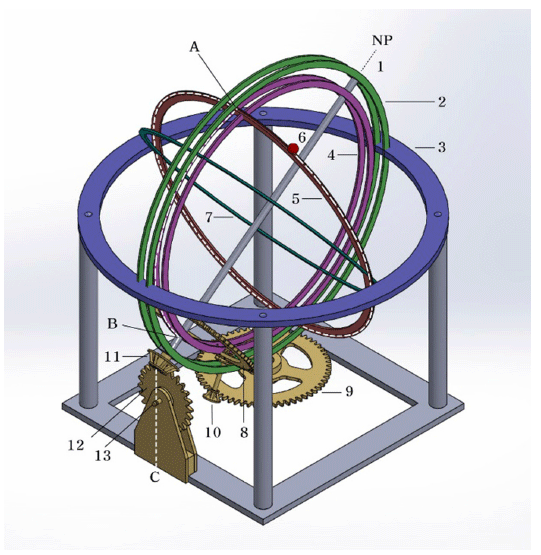
As a result, a 61-tooth gear was used for the celestial gear wheel, and a 73-tooth gear for the diurnal motion gear ring. Also, a 5-tooth gear was used for the celestial gear wheel side of the connection gear, and a 6-tooth gear for the diurnal motion gear ring side, so that the movement of the celestial gear wheel and the diurnal motion gear ring would have a rotation ratio of 366:365. Using this result, the fact that the celestial bodies on the celestial sphere rotate by approximately 1° more when the sidereal component completes one rotation every day could be reflected. This occurs because the sidereal day is shorter than the solar day.
In addition, the South Pole gear and sun movement gear of the armillary sphere were installed so that the sun-image on the ecliptic could move eastward by 1° every day. The South Pole gear rotates once a day, consists of an 8-tooth gear, and engages with the 24-tooth sun movement gear. Based on this, the position of the sun was corrected (i.e., moved eastward) on the ecliptic when the sidereal component where the sun is hung rotates a little more every day, so that the sun would be properly located every day at noon. The string where the sun-image is connected comes out through the interior of the solstitial-colure double ring at the summer solstice (A), toward the South Pole gear (11), and it is wound around the sun movement gear axis (13) and faces downward (C). A weight is connected to this string, and thus it is pulled tight. This string drags the sun on the ecliptic ring by approximately 1° every day.
4.DESIGN OF THE POWER TRANSMISSION MECHANISM
The power transmission mechanism of Heumgyeonggaknu consists of the water supply apparatus, the water wheel control system, the mechanism wheel system, and the sun movement apparatus. Of these, the water supply apparatus corresponds to a three-stage large/middle/small-sized outflow vessel water clock equipped with a water storage tank and an overflow function. When a certain amount of water is transferred to the scoop of the water wheel through the water clock, the Cheonhyeong apparatus controls the operation of the water wheel. Each mechanism wheel is rotated by the generated constant water wheel power. The 37 time signal puppets are then operated by the lug of the mechanism wheel or by the diurnal motion gear ring, or the power is used for the movement of the sun. In this study, the major mechanisms relevant to the power generation and transmission of Heumgyeonggak- nu were designed, with a focus on the water wheel control system, the mechanism wheel system, and the sun movement apparatus.
The water wheel control system consists of water wheel, scoop, Cheonhyeong apparatus, and water wheel main shaft (Fig. 5). The water wheel with a size of about 5 ja and the 16 scoops are organically operated by the Cheonhyeong apparatus. The water wheel main shaft consists of a 6-tooth gear, and the water wheel rotates 61 times a day. Thus, the water wheel main shaft proceeds through as much as a total of 366 teeth and the power gear wheel with a 366-tooth gear rotates once a day.
The mechanism wheel system consists of a total of five floors, in which the celestial gear wheel, 4-god gear wheel, time signal gear wheel, 12-god gear wheel, and power gear wheel are connected to the mechanism wheel main shaft (Fig. 6). The celestial gear wheel consists of a 61-tooth gear; and for the 4-god gear wheel, the lug taking charge of the operation of 4-god ognyeo and 4 gods is installed. The time signal gear wheel controls Sasin, Jongin (鐘人, striking bell puppet), Goin (鼓人, striking drum puppet), and Jeongin (鉦 人, striking gong puppet) on the time signal platform, and generates signals for the Jujeon apparatus for the hammering of bell∙drum∙gong.5
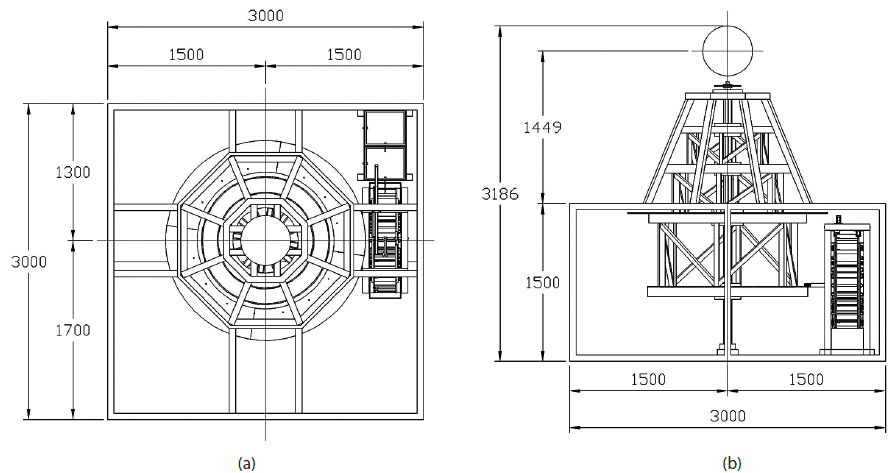
The celestial gear wheel is located at the top of the mechanism wheel main shaft, and supports the movement of the sun. The diurnal motion gear ring of the armillary sphere is operated by the power received from the celestial gear wheel (Fig. 7). A connection gear (consisting of 5-tooth gear and 6-tooth gear) is installed so that the rotation ratio of the celestial gear wheel (61-tooth gear) to the diurnal motion gear ring (73-tooth gear) is 366:365 (=73.2:73) when the power gear wheel completes one rotation (366-tooth gear). As a result, the diurnal motion gear ring rotates 0.2-teeth more every day. Through this, the image of the night sky is rotated by approximately 1° more based on the same time every day. Thus, the sun-image is moved eastward by 1°, which implements the movement of the sun on the ecliptic and also implements the culmination of the sun at around noon every day.
5.DISCUSSION
In Jegayeoksangjip (諸家曆象集), which was written by Lee, Sun-ji (李純之, 1406~1465) in the early Joseon Dynasty, a description of Shui Yun Yi Xiang Tai, an automated water clock of the Northern Song Dynasty, is included. Thus, it is expected that Jang, Yeong-sil, who was a contemporary of Lee, Sun-ji, sufficiently examined and analyzed Shui Yun Yi Xiang Tai. It is thought that when Jang, Yeong-sil designed the power and time signal system of Heumgyeonggak-nu, he developed a new type of water clock by correcting the operation mechanism of Borugak-nu, which had been developed earlier.
Shui Yun Yi Xiang Tai was a comprehensive astronomical clock, incorporating a water clock, water wheel, Cheonhyeong apparatus, time-keeping wheels, time signal puppets, Honui and Honsang. The operation of the water-hammer type Honui·Honsang and the manufacture of the water-hammer type Heumgyeonggak-nu in the early Joseon Dynasty can be considered a technological achievement, as it separated two types of new clock devices based on Shui Yun Yi Xiang Tai.
The researchers in the Suwako Watch & Clock Museum in Nagano Prefecture, Japan manufactured Shui Yun Yi Xiang Tai that can be actually operated. Yamada & Tsuchiya (1997) presented the blueprint of the major components of Shui Yun Yi Xiang Tai that had been analyzed through the manufacturing process. We compared the manufacturing accomplishments of Yamada & Tsuchiya (1997) with the design of the major components of Heumgyeonggak-nu (Table 2).
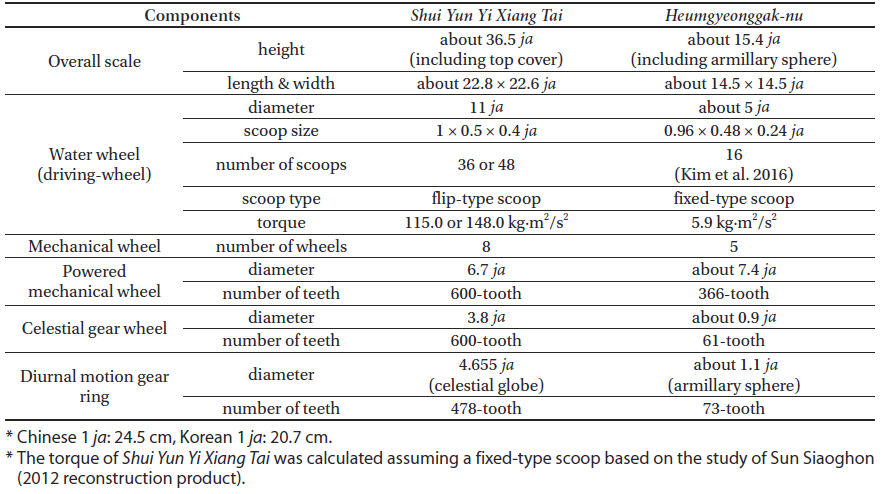
|
The overall height of Shui Yun Yi Xiang Tai is about 36.5 ja (894.25 cm), while the height of Heumgyeonggak-nu is about 15.4 ja (318.6 cm), a 2.8-fold difference. The diameter of the water wheel for power generation for Shui Yun Yi Xiang Tai is 11 ja (269.5 cm), while for Heumgyeonggak-nu it is about 5 ja (100 cm), a 2.7-fold difference. Shui Yun Yi Xiang Tai has 36 scoops, and Heumgyeonggak-nu has 16 scoops. Yamada & Tsuchiya (1997) manufactured a flip-type scoop, but we calculated the torque based on a fixed-type scoop as per the study of Sun Siaoghon (2012 reconstruction product).6
For the water wheel of Heumgyeonggak-nu, 16 scoops are uniformly installed around a circle. Thus, the angle between two scoops is 22.5°. The scoop has a size of 150 × 200 × 50 (l×w×t) mm, but the outermost part has a 45° inclined face. This is to decrease the error of the rotation power by minimizing the water that remains after pouring out water into the sump when the scoop filled with water completes 1 step rotation (22.5°). The distance from the center axis of the water wheel to the center of the scoop was designed to be 395.5 mm.
The position at which the scoop initially receives water from the outflow vessel is assumed to be 0°, and the mass of the water when the scoop is completely filled with water is expressed as m0. At this moment, the volume is . As the specific gravity of water is 1 kg/cm3, m0 = 1.25 kg. Also, the amount of water remaining when the scoop completes 1 step rotation (22.5°) is . The weight of the water for two scoops is 15.7 kg·m/s2. When it is assumed that the distances from the centers of gravity of the two scoops filled with water to the center of the water wheel are approximately the same (h), the torque is .
On the other hand, the scoop of Shui Yun Yi Xiang Tai has a size of 1.0×0.5×0.4 (l × w ×1 t) [ja]. The volume is 2.94 l, and the mass of water when the scoop is completely filled with water is 2.94 kg. Also, the scoop is fixed at the prop of the water wheel. When the scoop that is full of water completes 1 step rotation, the water is not completely emptied. The remaining water continuously applies torque to the water wheel.
The water wheel of Shui Yun Yi Xiang Tai has 36 or 48 scoops. The torque could vary depending on the number of scoops. During the 1 step rotation, the 36 scoops move 10°, while the 48 scoops move 7.5°. The torque for the two scoop types can be expressed as follows. In this regard, it is assumed that the distances from the centers of gravity of all the scoops filled with water to the center of the water wheel are the same.(1)(2)
where h is the distance from the center of gravity of the scoop to the center of the water wheel, and it is 5 ja (1.225 m). l is the length of the scoop, w is the width, and t is the depth. n represents each step by which the scoop is inclined relative to the horizontal plane (0).
When Shui Yun Yi Xiang Tai has 36 scoops, water remains in 9 scoops; when it has 48 scoops, water remains in 12 scoops. 9.5 kg and 12.3 kg of water remain, respectively; thus, during the 1 step rotation, the water applies a lot of force and torque to Cheonhyeong (Table 3.). The torque for the 36 scoops is 115.0 kg∙m2/s2, and for the 48 scoops it is 148.0 kg∙m2/s2. These values are about 19.5 and 25.1 times the torque of Heumgyeonggak-nu, respectively.
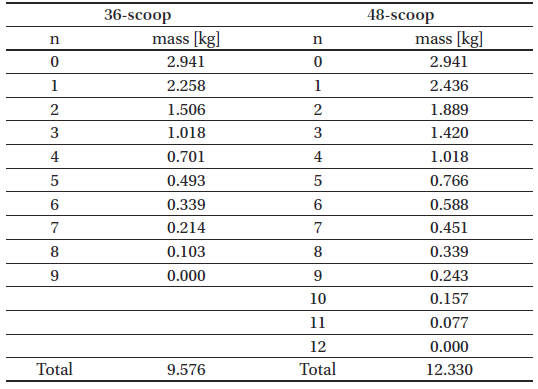
|
In the case of Heumgyeonggak-nu, an armillary sphere is installed above the shape of the mountain, and thus, the celestial gear wheel at the top of the five-story mechanism wheels was designed to have the smallest diameter. Accordingly, the size is much smaller than that of the rectangular Shui Yun Yi Xiang Tai, and the size of the diurnal motion gear ring also becomes small. In the case of Shui Yun Yi Xiang Tai, the number of teeth for the celestial gear wheel and for the diurnal motion gear ring are 600 and 478, respectively (when it has 36 scoops); in the case of Heumgyeonggak-nu, they are 61 and 73, respectively. To transfer power based on these different numbers of teeth, two connection gears are used for Shui Yun Yi Xiang Tai; in the case of Heumgyeonggak-nu, one connection gear is used to express the movement of stars.
Fig. 8 shows a top view of the completed operation part of Heumgyeonggak-nu. The five-story mechanism wheels are located below the armillary sphere, and the water clock and water wheel control system are located on the right side. The overall position of the replica of a mountain was moved to the north so that the space for the display of the tilting vessel could be prepared on the south. For the display on the mountain and the stable operation of the operation part, a basic frame supporting the replica of a mountain and the wooden case was designed.
6.CONCLUSIONS
We investigated the power transmission structure and design of Heumgyeonggak-nu, which correspond to the internal space. The design was performed based on a total of three areas: the water wheel control system which includes the water clock for stable water supply and the Cheonhyeong apparatus for maintaining the constant rotation speed of the water wheel, the mechanism wheel system in which the five-story mechanism wheels are rotated by the power of the water wheel, and the sun movement apparatus in which the movement of the sun is implemented by the operation of the celestial gear wheel located at the top of the mechanism wheels.
The water clock consists of three-stage large/middle/ small-sized outflow vessels, and has an overflow function. The inscription of Cheonjiho is engraved on the large-sized outflow vessel, and it is installed outside the replica of a mountain. For the large-sized outflow vessel, the flow of water is broadly divided into two directions. The water through the stream tube of the large-sized outflow vessel goes through the middle-sized outflow vessel and the smallsized outflow vessel, and is directly supplied to the water wheel control system. The extra water through the overflow tube of the large-sized outflow vessel is used for the display of the waterfall, pond, and tilting vessel.
The scoop of the water wheel was designed as a fixed type, and the rotation of the water wheel is controlled by the Cheonhyeong apparatus. The water wheel rotates 61 times, and thus the 6-tooth gear of the water wheel main shaft proceeds through as much as a total of 366 teeth. The upper side of the power gear wheel consists of a 366-tooth gear, and it engages with the 6-tooth gear of the water wheel main shaft. When the power gear wheel completes one rotation, the celestial gear wheel, 4-god gear wheel, time signal gear wheel, and 12-god gear wheel that are connected to the mechanism wheel main shaft are rotated together. The celestial gear wheel consists of a 61-tooth gear, and the power is transferred to the diurnal motion gear ring consisting of a 73-tooth gear, through the connection gear.
For the movement of the sun, an armillary sphere was installed on top of the replica mountain. The movement of the sun-image is implemented using the power transferred to the diurnal motion gear ring of the armillary sphere. For the sun-image, the rotation ratio of the celestial gear wheel to the diurnal motion gear ring was set to 366:365, so that the sidereal component could rotate once a day and could move by approximately 1° more. In this regard, the sun was designed to retreat by approximately 1° on the ecliptic so that the position of the sun could be properly expressed depending on the solar term and the solar altitude could be changed based on this.
We thoroughly summarized and designed the mechanism by which the power of Heumgyeonggak-nu is generated and transferred to each mechanism wheel. In this process, several errors and supplementations of previous research were examined in detail (position correction of 4-god ognyeo and 4 gods, water wheel scoop improvement, and detail design that implemented the conceptual design). It is expected that the results of this study will lay the foundation for the organic operation of the 37 time signal puppets and the major apparatus that connects the interior/exterior of the replica mountain.
